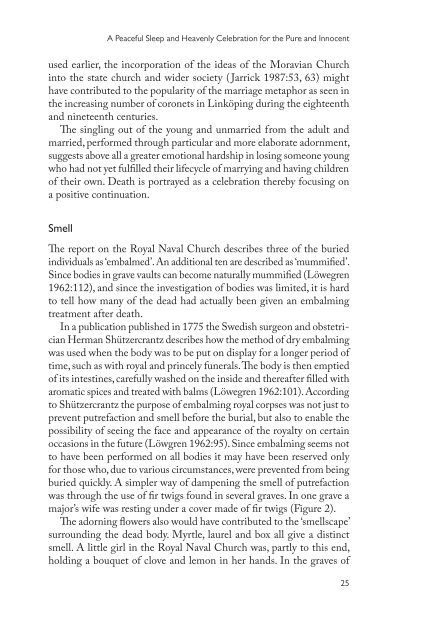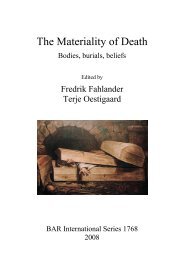Making Sense of Things
Making Sense of Things
Making Sense of Things
Create successful ePaper yourself
Turn your PDF publications into a flip-book with our unique Google optimized e-Paper software.
A Peaceful Sleep and Heavenly Celebration for the Pure and Innocent<br />
used earlier, the incorporation <strong>of</strong> the ideas <strong>of</strong> the Moravian Church<br />
into the state church and wider society ( Jarrick 1987:53, 63) might<br />
have contributed to the popularity <strong>of</strong> the marriage metaphor as seen in<br />
the increasing number <strong>of</strong> coronets in Linköping during the eighteenth<br />
and nineteenth centuries.<br />
The singling out <strong>of</strong> the young and unmarried from the adult and<br />
married, performed through particular and more elaborate adornment,<br />
suggests above all a greater emotional hardship in losing someone young<br />
who had not yet fulfilled their lifecycle <strong>of</strong> marrying and having children<br />
<strong>of</strong> their own. Death is portrayed as a celebration thereby focusing on<br />
a positive continuation.<br />
Smell<br />
The report on the Royal Naval Church describes three <strong>of</strong> the buried<br />
individuals as ‘embalmed’. An additional ten are described as ‘mummified’.<br />
Since bodies in grave vaults can become naturally mummified (Löwegren<br />
1962:112), and since the investigation <strong>of</strong> bodies was limited, it is hard<br />
to tell how many <strong>of</strong> the dead had actually been given an embalming<br />
treatment after death.<br />
In a publication published in 1775 the Swedish surgeon and obstetrician<br />
Herman Shützercrantz describes how the method <strong>of</strong> dry embalming<br />
was used when the body was to be put on display for a longer period <strong>of</strong><br />
time, such as with royal and princely funerals. The body is then emptied<br />
<strong>of</strong> its intestines, carefully washed on the inside and thereafter filled with<br />
aromatic spices and treated with balms (Löwegren 1962:101). According<br />
to Shützercrantz the purpose <strong>of</strong> embalming royal corpses was not just to<br />
prevent putrefaction and smell before the burial, but also to enable the<br />
possibility <strong>of</strong> seeing the face and appearance <strong>of</strong> the royalty on certain<br />
occasions in the future (Löwgren 1962:95). Since embalming seems not<br />
to have been performed on all bodies it may have been reserved only<br />
for those who, due to various circumstances, were prevented from being<br />
buried quickly. A simpler way <strong>of</strong> dampening the smell <strong>of</strong> putrefaction<br />
was through the use <strong>of</strong> fir twigs found in several graves. In one grave a<br />
major’s wife was resting under a cover made <strong>of</strong> fir twigs (Figure 2).<br />
The adorning flowers also would have contributed to the ‘smellscape’<br />
surrounding the dead body. Myrtle, laurel and box all give a distinct<br />
smell. A little girl in the Royal Naval Church was, partly to this end,<br />
holding a bouquet <strong>of</strong> clove and lemon in her hands. In the graves <strong>of</strong><br />
25

















